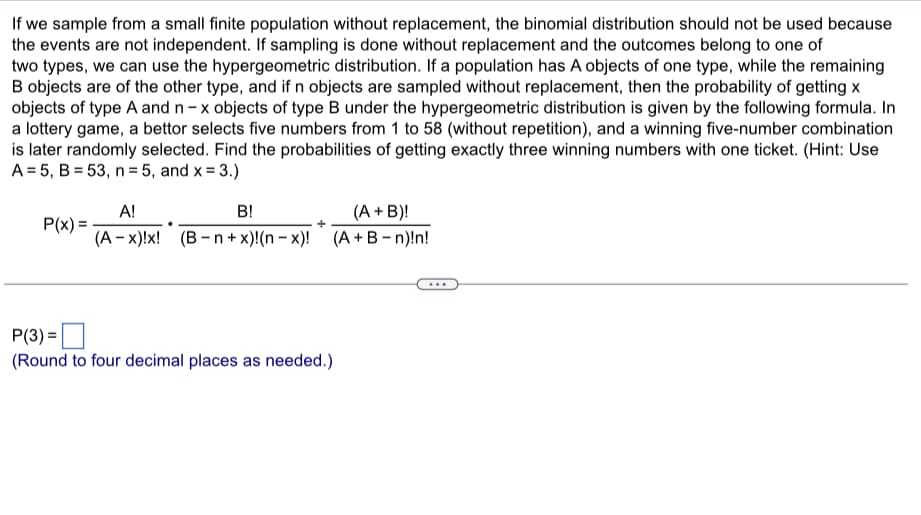If we sample from a small finite population without replacement, the binomial distribution should not be used because the events are not independent. If sampling is done without replacement and the outcomes belong to one of two types, we can use the hypergeometric distribution. If a population has A objects of one type, while the remaining B objects are of the other type, and if n objects are sampled without replacement, then the probability of getting x objects of type A and n-x objects of type B under the hypergeometric distribution is given by the following formula. In a lottery game, a bettor selects five numbers from 1 to 58 (without repetition), and a winning five-number combination is later randomly selected. Find the probabilities of getting exactly three winning numbers with one ticket. (Hint: Use A = 5, B = 53, n = 5, and x = 3.) P(x) = A! B! (A-x)!x! (B-n+x)!(n-x)! (A + B)! (A+B-n)!n! P(3)= (Round to four decimal places as needed.)
If we sample from a small finite population without replacement, the binomial distribution should not be used because the events are not independent. If sampling is done without replacement and the outcomes belong to one of two types, we can use the hypergeometric distribution. If a population has A objects of one type, while the remaining B objects are of the other type, and if n objects are sampled without replacement, then the probability of getting x objects of type A and n-x objects of type B under the hypergeometric distribution is given by the following formula. In a lottery game, a bettor selects five numbers from 1 to 58 (without repetition), and a winning five-number combination is later randomly selected. Find the probabilities of getting exactly three winning numbers with one ticket. (Hint: Use A = 5, B = 53, n = 5, and x = 3.) P(x) = A! B! (A-x)!x! (B-n+x)!(n-x)! (A + B)! (A+B-n)!n! P(3)= (Round to four decimal places as needed.)
College Algebra
7th Edition
ISBN:9781305115545
Author:James Stewart, Lothar Redlin, Saleem Watson
Publisher:James Stewart, Lothar Redlin, Saleem Watson
Chapter9: Counting And Probability
Section9.3: Binomial Probability
Problem 2E: If a binomial experiment has probability p success, then the probability of failure is...
Related questions
Question
100%

Transcribed Image Text:If we sample from a small finite population without replacement, the binomial distribution should not be used because
the events are not independent. If sampling is done without replacement and the outcomes belong to one of
two types, we can use the hypergeometric distribution. If a population has A objects of one type, while the remaining
B objects are of the other type, and if n objects are sampled without replacement, then the probability of getting x
objects of type A and n-x objects of type B under the hypergeometric distribution is given by the following formula. In
a lottery game, a bettor selects five numbers from 1 to 58 (without repetition), and a winning five-number combination
is later randomly selected. Find the probabilities of getting exactly three winning numbers with one ticket. (Hint: Use
A = 5, B = 53, n=5, and x = 3.)
P(x) =
A!
B!
(A + B)!
(A - x)!x! (B-n+x)!(n-x)! (A + B-n)!n!
P(3) =
(Round to four decimal places as needed.)
Expert Solution
This question has been solved!
Explore an expertly crafted, step-by-step solution for a thorough understanding of key concepts.
This is a popular solution!
Trending now
This is a popular solution!
Step by step
Solved in 3 steps with 1 images

Recommended textbooks for you

College Algebra
Algebra
ISBN:
9781305115545
Author:
James Stewart, Lothar Redlin, Saleem Watson
Publisher:
Cengage Learning


College Algebra
Algebra
ISBN:
9781305115545
Author:
James Stewart, Lothar Redlin, Saleem Watson
Publisher:
Cengage Learning
